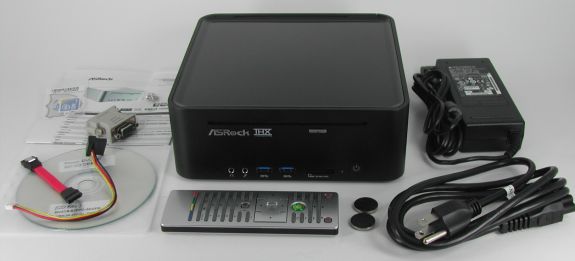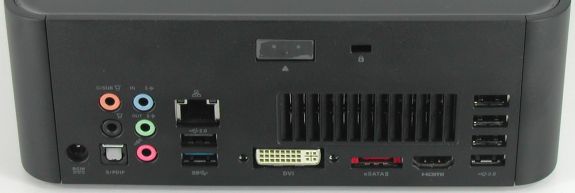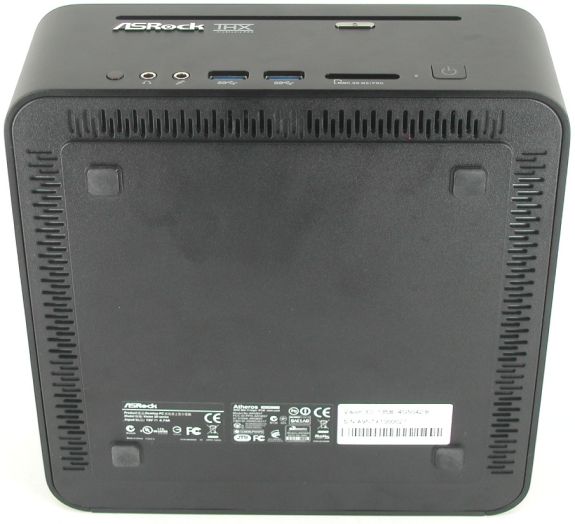ASRock's High-End Vision 3D HTPC Reviewed
by Ganesh T S on October 3, 2010 10:20 AM ESTThe ASRock Vision 3D HTPC package is similar in size to the Core 100 package.
Apart from the main unit, the package also bundles the following:
- 90W AC / DC Adapter
- SATA and power cables, as well as mounting screws for a 2.5" hard disk
- DVI to VGA adapter
- MCE remote and a couple of CR232 batteries.
- Manual with instructions for disassembling and replacing the MXM card
- CDs with drivers and ASRock utilities, as well as PowerDVD 3D BD Player (OEM version)
While the Core 100 and ION 330 shared a similar industrial design, ASRock realized that a high end HTPC needed a shift in appearance. It now brings a Mac Mini look, though the dimensions are still the same as that of the Core 100 and ION 330. The edges are no longer abrupt, and the slimline BD drive has been replaced by a slot loading one. These are exactly the points with which we found issues in the Core 100 review. Of course, people who are concerned with the aesthetics may object to the large number of ports and imprints on the front side of the unit. In a future design, ASRock may probably shift the imprints to the top panel and hide the front ports with a full width hinged door of sorts.
Like the Core 100, the front panel has two audio jacks and two USB ports. In addition, there is also a SD card reader. However, unlike the Core 100, there are no ventilation slots in the front panel. The IR receiver is also visible. Also, the sides of the chassis are not used as antennae for the Wi-Fi (there are two metal plates inside the chassis at the rear end for this purpose).
Moving to the rear of the unit, we have a power adapter input, GbE port, eSATA port and audio jacks similar to the Core 100. However, the VGA port in the Core 100 is replaced by a dual link DVI port in the Vision 3D. The HDMI port is also HDMI 1.4a. There are 5 USB 2.0 ports and 1 USB 3.0 port to wrap up the ports in the rear. Instead of a fan slot, we have air ventilation slots, which are of the type found on the sides of a notebook. There is also a provision for a Kensington lock and a push-button mechanism to lift off the top panel.
An interesting deviation from the Core 100 exterior design is the underside of the unit. While the Core 100 was plain and needed an anti-slip pad for stability, the Vision 3D is raised with rubber bushes, and also has ventilation slots three sides, as can be seen in the picture below.
Just like a notebook, this unit also supports simultaneous display on two monitors. Testing was done mostly with the HDMI output connected to a Toshiba REGZA 37" 1080p TV through an Onkyo TX-SR 606, and the DVI port connected to a old Dell monitor running at 1280x1024. The Vision 3D ships with no OS installed. For the purpose of this review, we loaded up a copy of Windows 7 Ultimate x64. It is also possible to install Ubuntu or any other Linux distribution and still be able to take advantage of most of the HTPC functions of the system. Our analysis in the rest of the article, however, is completely from the Windows 7 standpoint.
We will conclude this section with a table to summarize the data and A/V connectivity options for the Vision 3D HTPC.
| Option | Status |
|---|---|
| HDMI | Yes [v1.4a] |
| Component | No |
| Composite | No |
| VGA | Yes [with DVI-VGA adapter] |
| SPDIF | Yes [Optical] |
| Stereo | Yes |
| Option | Status |
|---|---|
| Optical Disk Drive | Yes [Blu-Ray] |
| USB | Yes [5 x v2.0, 3 x v3.0] |
| eSATA | Yes |
| LAN | Yes [ 1000 Mbps GbE ] |
| Internal HDD | Yes [ 500 GB ] |
| WiFi | Yes [ 300 Mbps 802.11n ] |
| Card Reader | Yes |














51 Comments
View All Comments
ganeshts - Sunday, October 3, 2010 - link
Thanks, fixed :)nitrousoxide - Sunday, October 3, 2010 - link
A Seagate Barracuda Momentus XT 500GB would do much better job than WD Scorpio Black.LtGoonRush - Sunday, October 3, 2010 - link
A Seagate Momentus XT 500GB would cost nearly twice as much as the WD Scorpio Black 500GB ($130 vs $75 at retail), and the performance difference is rather unimpressive. In the tests where the Seagate can make use of its SLC cache it can take the lead, but in most tests the Scorpio Black is faster, especially when seek times or write performance come into play, since those are Seagate's major weaknesses.BansheeX - Sunday, October 3, 2010 - link
Cool box but LOL at the THX logo being slapped on it. They used to put that on heavily compressed DVD mixes, not all of them good either. Consumers don't care anymore.ganeshts - Sunday, October 3, 2010 - link
Personally, I don't care too much about the THX either :) If you are using HDMI for audio, it doesn't even appear in the picture.The internal audio codec is advertised with THX, so the HTPC using it gets the additional marketing point too :)
tobrien - Sunday, October 3, 2010 - link
you guys did such an excellent job with this review! thanks for all the hard work and effort you guys put in!Shiitaki - Sunday, October 3, 2010 - link
I'm not seeing the value here. A thousand dollars to stream content, and play blurays? One of the previous replies you stated that there was no native bluray support for the mac mini, true. And there is for a machine running windows? Tacking on Cyberlink is not native support.That is way too much hardware for what it does, which illustrates how badly Windows is for a platform. You could do much better with less hardware. Which is the real problem with a htpc, the software, the operating system, and various codecs, and getting it to all work together. Too much complexity. Most of the processor is wasted on layers of software instead of doing actual work. Most of the effort is expended to compensate for lazy and inadequate programming, as well as DRM.
I understand the concept, I had a htpc for a couple of years, but after the frustration of trying to get surround sound to work in Cyberlink for Blurays, and the tech support to keep Windows working, I gave up. In fact it was specifically windows deciding to rebuild my music library from scratch every time I opened media center to play music. I want an appliance on the other end of the remote, having to search forums and break out a mouse and keyboard to trouble shoot something that worked the day before just fine should not be step two after pressing the power button.
In the the article, there is no details as to how much or little work it took to make the software environment to work. Did settings hold, did you have to do reconfigurations, update drivers, load codecs? I seriously doubt it worked out of the box. Working out of the box is the great failure of the pc industry. On the video quality you are hedging, saying that video quality will get better with driver updates? So it's not finished eh? That's the sad reality with the computer industry in general, nothing ships as a finished product.
The only thing this device seems to offer are endless possibilities to reward owners with a sense of accomplishment having solved issues preventing operations promised by the vendor. You can buy a nice bluray player, wd live, and still have 700 dollars for something else.
The real news is if you took it out of the box, plugged everything in, did a setup once, and spent the rest of the time using it. No drivers, patches, settings that reset themselves, or promises of a future update for something to work So what did it take to make it work like it's supposed to, what issues does it have? Did you listen to two channel, or full surround? How many error messages did you have to deal with?
ganeshts - Monday, October 4, 2010 - link
What you are looking for is a player like the upcoming Netgear NTV550. That would put it in the media streamer section. That would be like $700 cheaper than the Vision 3D, but, with the NTV choice, you are at the mercy of Netgear for firmware updates in case something you want doesn't work, and it also doesn't support 3D -- which is what this product is targeted towards.. For the Vision 3D running Windows, you have a number of open source developers who can enable core features like HD audio bitstreaming etc. -- Try getting open source devs to get those sort of features working on a SoC based device.The fact with the HTPC scene is that you do have to do some setup of sorts and deal with error messages and what no. However, sometimes, slapping on the latest XBMC build solves most problems. Our test suite is designed to give problems to various softwares, so deriding drivers / softwares on the basis of the difficulty in getting it to work is not the purpose of the review.
ggathagan - Monday, October 4, 2010 - link
Everything you state is true but, unfortunately, that can be said of computers in general. It's not limited to HTPC.You're also missing one of the major points of the HTPC: Its ability as a computer.
You don't get that from a standalone device.
You don't specify what version of MCE you were using, but if you weren't using the Windows 7 version it's not really a valid arguement.
I never tried the Vista version, but the Win 7 version has certainly come a looong way from the XP version.
And if you happen to be someone on a budget that wants to do it all with a single device, the price of the ASRock system is pretty attractive, even after adding the cost of the OS, monitor and BD software.
Hrel - Monday, October 4, 2010 - link
Pretty sure the hybrid Seagate Momentus XT is the fastest 2.5" drive they could have chosen. To all the other people talking about this egregious error, WD and Seagate are the only mechanical disk hard drive manufacturer's even worth looking at.